16 May
lecture series
EIGHT CENTURIES OF THE PRESENCE OF THE ORDER OF PREACHERS IN NAVARRA: FROM THE GOTHIC TO THE BAROQUE PERIOD
The Dominicans in Navarre: a presence of eight centuries
Jesús Galdeano (O.P.)
Prior PP. Dominicans of Pamplona
These conferences are the culmination of the celebration of the 8th centenary of the Confirmation of the Order of Preachers by Pope Honorius III. The Order arrived in Navarre in the first third of the 13th century and had a significant presence throughout these 8 centuries.
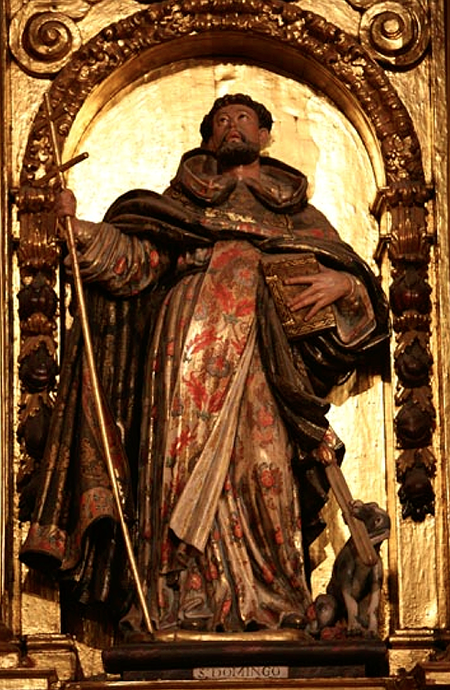
Saint Dominic of Guzmán.
Altarpiece of San Fermín. Pamplona Cathedral
1.- A new charism in the Church: Dominic and the Dominicans
The Dominicans were founded in 1215 with the aim of imitating the "apostolic life" of the first Christian community and defending the faith against heresies. purpose . Their mission statement was to preach the Word of God in its entirety, a task which until then had been the exclusive preserve of the bishops. Pope Honorius III confirmed the Order on 22 December 1216. On 15 August 1217, the founder Dominic of Guzman (1170-1221) dispersed the 16 companions. "I know well what I am doing, wheat that is heaped together rots, wheat that is scattered bears fruit", he replied to the friars and protectors who listened incredulously to his decision. He sent them to the university towns and established that no friary should be founded without a prior and a doctor. With the Order structured into eight provinces and more than sixty communities, he died in 1221 in Bologna, where his remains remain. In 1234 he was canonised by Pope Gregory IX.
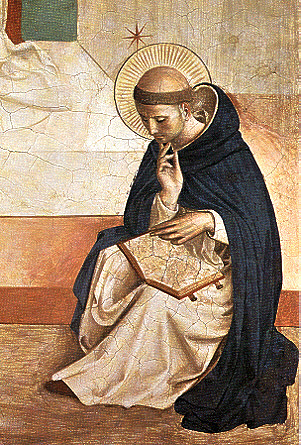
Saint Dominic of Guzman, by Fra Angelico
(Convent of San Marco, Florence)
The Order of Preachers is made up of friars, contemplative nuns, sisters of apostolic life and lay people ("Third Order"). Our motto: contemplata aliis tradere (to pass on to others what is contemplated). At present, the Order has 6,000 friars, 300 secular priests of the fraternity of St. Dominic, 2,200 contemplative nuns, 23,000 Sisters of Apostolic Life, 160,000 lay people and 1,300 participants in the MJD (Dominican Youth Movement).
2.- Historical presences in Navarre
2.1.- Convent of Santiago in Pamplona
In 1217, four friars sent by Domingo arrived in Madrid and by 1230 there is evidence of their presence in Pamplona. They settled in a small Shrine of Our Lady of Fair Love, on the outskirts of the city, dedicated to Santiago. Their commitment was to attend to the cult and the large and influential Confraternity.
The convent was of great importance in the Order and in Navarrese society, as is shown by the fact that several provincial and general chapters were held there, the special protection it enjoyed from the royal family of Navarre, its preaching throughout the kingdom on patron saint's feasts and great solemnities, its intellectual activity and its great role in the defence of the faith against heresies and superstitious practices, which were abundant in the region. They created and spiritually supported the Confraternities of the Rosary and the Virgin of Nieva.
In 1512 the troops of Ferdinand the Catholic, commanded by the Duke of Alba, conquered Pamplona. During the siege and occupation, the convent suffered considerable damage. Faced with the French threat, the king decided to build a castle on the site of the convent, to which he granted a new site on the site it occupies today. Work on the new convent began in 1520 but was not completed until 1729. The foundations of the church were laid in 1537 and completed in 1568.
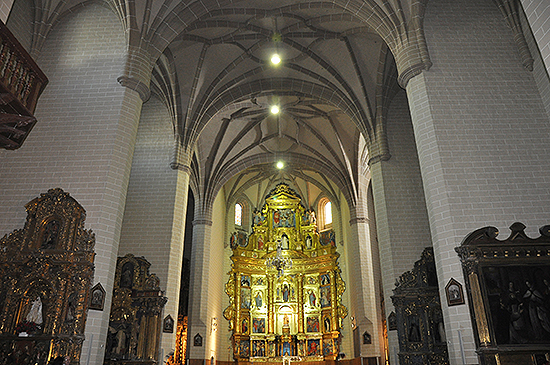
Convent of Santiago, of PP. Dominicans in Pamplona. Inside
By 1553 it already had programs of study of Theology and in 1630 the University of Santiago was created. It could teach Degrees in Arts and Philosophy and in Theology. It was definitively suppressed on 11 March 1771. It was the centre where the religious who were to form the intellectual elite of the Kingdom, the Basque Country and other Spanish provinces received teaching and Degrees .
From 1809 to 1814, the friars lived outside the convent by order of J. Bonaparte who had decreed the suppression of all the convents and the seizure of their property. The convent was converted into barracks for the French and suffered enormous damage. In 1814, they were reunited. In 1837, as a consequence of the exclaustration and extinction of the religious orders in Spain, the friars had to leave the convent. By virtue of the confiscation that followed the exclaustration, their property was sold at derisory prices. The convent was used as a barracks and then as a military hospital. The church became the property of the bishopric.
2.2.- Convent of Santo Domingo, Estella
In 1259, construction began on the best example of Gothic architecture in Navarre, according to some experts. From the beginning, like all Dominican convents, it was a centre for programs of study and preaching. In the 14th century, Latin and Arabic were already being taught, and in the 18th and 19th centuries there was a moral theology Chair for those aspiring to the priesthood. In 1809, the commissioner for the suppression of the religious convents in Navarre required the prior to dissolve them. Its assets were handed over to the commanders of the French troops garrisoned in Estella. In 1814, the Community returned to the convent, stripped of everything. Peace was short-lived. In 1821 they were evicted by the liberals. In 1823 they returned again, but the third and last expulsion came in January 1839. The monastery gradually crumbled into ruins. It was rebuilt by the Government of Navarre, but after a brief stay by the Dominicans, it was dedicated to residency program for the elderly.
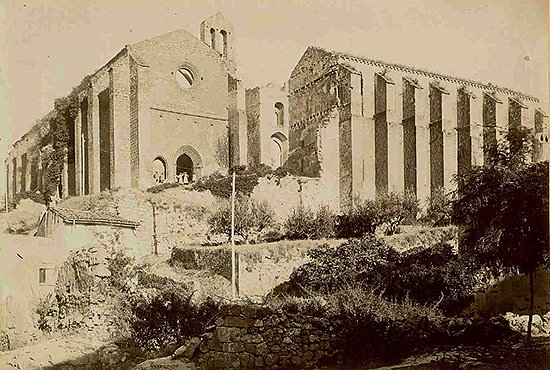
Former convent of Santo Domingo. Estella
2.3.- Convent of Santo Domingo, Sangüesa
Sanguesa was a flourishing town and, throughout the 13th century, the mendicant orders settled in its four cardinal points around the walled enclosure. The Order of Preachers settled in 1221, with religious brought by Saint Dominic. Theobald II left them 2,000 sueldos in his will. Philip III authorised them to build a new convent outside the walls opposite the palace-castle. In 1366 it was demolished because of the wars with Aragon and moved inland. licence In 1379, Charles II granted them a plot of land in the Aljama, the Synagogue and the Jewish hospital, where, following the approval of Pope Clement VII, they built their convent, which was completed in 1388. It disappeared after the disentailment in 1835.
2.4.- Convent of El Rosario, Tudela
It was founded in 1517. The convent was totally ruined during the French occupation in the years 1810-1812 and in 1821 it was finally suppressed.
2.5.- Convent of N.P. Santo Domingo, Contemplative Nuns,Tudela
Founded in 1622, it remained there until 2010 when the community moved to the Monastery of Casalarreina (La Rioja). It is currently home to the Pilgrims of the Camino de Santiago. The church was built later, between 1681-1689.
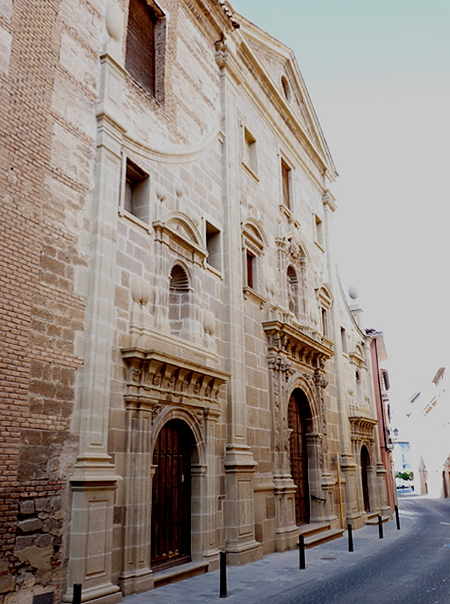
Façade of the convent of Santo Domingo de Tudela
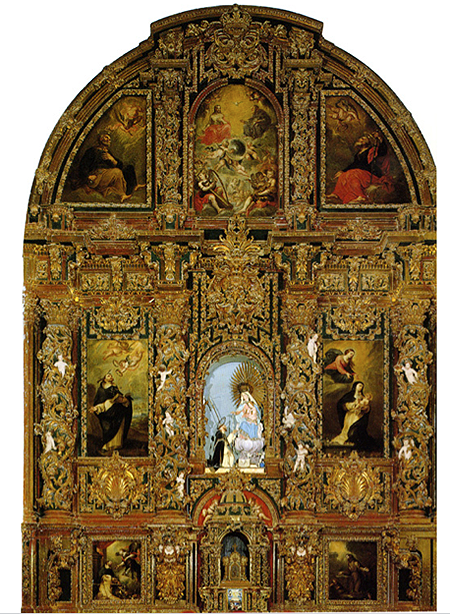
Altarpiece of the convent of Santo Domingo de Tudela
3.- CURRENT PRESENCES
In Navarre there is a community of friars, with three presences (Pamplona, Gorraiz and Villava) and 4 Congregations of Sisters of Apostolic Life, in Pamplona, Barañain, Tudela and Villava.
3.1.- Community of friars "San Valentín de Berrio-Ochoa".
a) Villava Convent
Besta Jira" ("around the game") was a playhouse. In 1915 the Dominican Fathers acquired it and opened a high school for the Education of the children of the village. From 1938 to 1973 it became the "seminar Hispanoamerican Dominican Missionaries". It was also the novitiate of the Cooperator Brothers. Radio Popular was born here and later continued in the convent of Pamplona. At present it is the residency program- infirmary for the assisted elderly Dominicans of the "Hispania" Province.
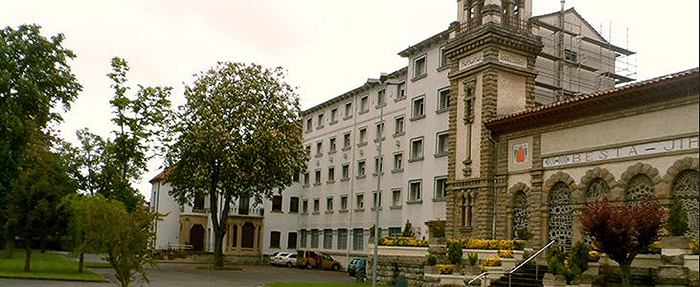
Dominican convent of Villava
b) Convent of Santo Domingo in Pamplona. Restoration
In 1914, the Church of Santiago was returned to the Dominicans. They did not get an inch of land from their convent. In 1918 they built a tenement on the atrium of entrance to the church. The apostolic activity had a few years of splendour, with church services, youth weeks, religious services in various schools and the direction of Radio Popular, with programmes of enormous broadcasting such as Matemáticas de Dios and the Concurso de Villancicos nuevos (New Christmas Carols Competition). Currently, with the transformation partner-demographic and religious transformation of the old quarter of Pamplona, it is considering the meaning of its mission statement and the future of the community.
c) Parish of Gorraiz
In 1997 a new parish was created in Gorráiz, in the outskirts of Pamplona, to attend to the community of this new urbanisation. In 1998 the parish was entrusted to the Dominican Order. In 2001 the old Shrine of Our Lady of Fair Love of San Esteban was inaugurated and in 2006 the new church and parish house with all the pastoral facilities, the work of the architect Joaquín Arellano Rodríguez, were opened. The church's altarpiece has an iconographic diptych depicting San Esteban, the work of the painter Juan José Aquerreta; stained glass windows by Fernando Pagola and Domingo Iturgaiz; Víacrucis-Víalucis by Antonio Oteiza; a mechanical pipe organ by Joaquín Lois and bronze doors by the sculptor M. Iribertegui.

Parish Church of San Esteban de Gorraiz
3.2.- Dominican Sisters of the teaching of the Immaculate Conception (Jarauta)
In the beginning, around 1400, the community was a beaterio. In 1597 they professed the three vows and the first Dominican community was constituted. Dedicated to Education as a boarding school, in 1798 the Pamplona City Council entrusted them with the management of the first public school for girls to be opened in the capital of Navarre. They ran it until 1873. For 75 years it has been the only public school for girls and the centre of reference letter education for the whole city. In 1876 they opened a public school and in 1897 they started a boarding school.
They currently have 3 communities in Pamplona: The high school in Calle Jarauta, the house in Rochapea and the residency program for the elderly in Zizur. They are dedicated to teaching at high school and collaborate with Caritas and Social Services in the parishes. There is a fourth community of lay people, the DEIC community, made up of single and married people, who share the spirituality and the mission statement of the congregation.
3.3.- Dominican Missionary Sisters of the Holy Family, Villava (high school de la presentation)
In 1881, the Dominican nuns of Jarauta established themselves in Villava, seeking open and healthy spaces for their boarders. Subsequently, the building was adapted for high school; they opened a dominial class for girls who could not attend the public school because they had to work and a mixed kindergarten, a significant novelty and important attention for the town and families.
In 1928 they joined the Congregation of the Dominican Sisters of the Holy Family, who now run it. In 1974 the present beautiful and practical high school was built, the work of the Dominican friar, Fr. Francisco Coello de Portugal. high school subsidised, with Education for infants, primary and secondary education. Bilingual and mixed. It is integrated in the FEDS Foundation. They collaborate with the village parish and with groups that promote a more supportive Villava, Justice and Peace.
Website: http://www.dominicasmsf.org
3.4.- Dominican Missionary Sisters of the Rosary (Barañáin)
The Congregation of the Dominican Missionary Sisters of the Rosary was founded in Lima (Peru) on 5 October 1918, with a missionary aim. Its founders were Monsignor Ramón Zubieta and Mother Ascensión Nicol, both Dominicans from Navarre. At present, the congregation, with 136 communities, is present in 21 countries. The novitiate was inaugurated on 15 September 1920, in the San Juan neighbourhood of Pamplona. In 1967 the novitiate was transferred to Madrid. And in 1970 the community moved to Barañáin, to the new convent designed by the Dominican architect, Fr Coello de Portugal. At present, the convent is a refuge for the sisters who need to take care of their health and live the last stage of their lives, next to the remains of the M. Foundress. There are 2 communities of 40 sisters each.
Website: http://www.misionerasdominicas.org.
3.5.- Dominicas de la Anunciata, Tudela (high school "La Anunciata")
The Congregation was founded in Vic (Barcelona) on 15 August 1856, "to announce the Message of Salvation, through the Education, to everyone, especially to children and young people". With a clear option for the Education of women and for the promotion of the popular classes.
They arrived in Navarre, Ribaforada, in 1939. They dedicated themselves to the Education of the youngest children and pastoral activities in the village. Over time they extended their activity to include typing and shorthand classes for teenage girls. Much loved by the village, they remained there until 2009, when they sold the building to the Town Hall, which continued their work.
On 4 February 1955, four sisters arrived in Tudela to found a high school and settled in the neighbourhood known as "Casas Baratas" (today the neighbourhood of Nuestra Señora de Lourdes), promoted by the Jesuit Father Jesús Lasa. In September 1957 the sisters moved into the new high school Nuestra Señora del Rosario, designed by Moneo. At present, teaching is used for Infant, Primary and Secondary education with three lines, and typing, shorthand and calculus classes are given. In 2005 they celebrated 50 years of presence in Tudela. They continue to promote an integral, human and Christian Education for the children and young people of La Ribera (Tudela) and a good issue of foreigners.
Website: http://dominicasanunciata.org
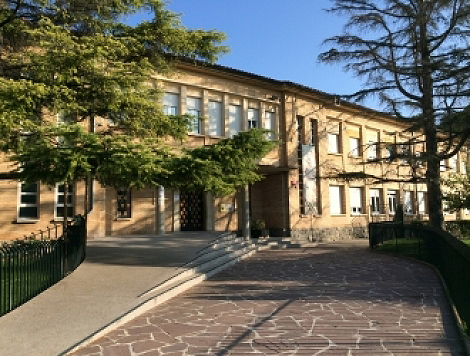
high school La Anunciata, Tudela
